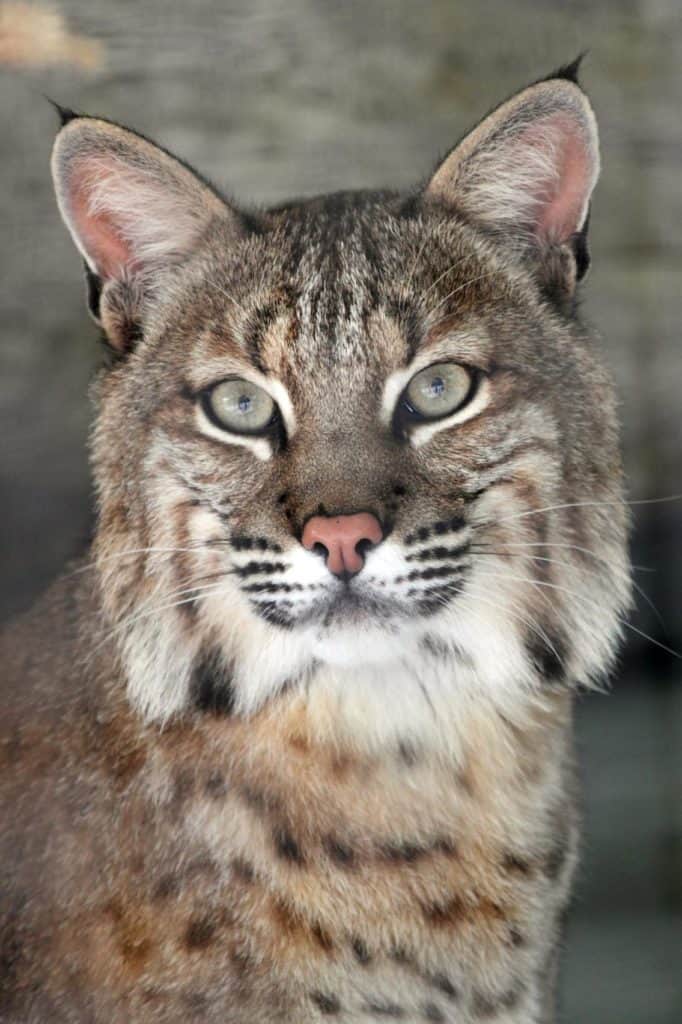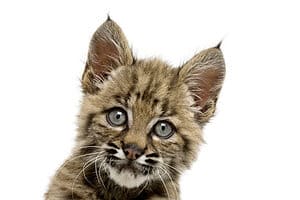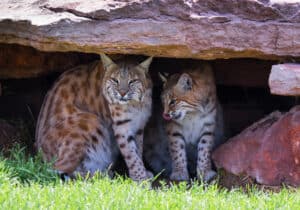Bobcats cover a wide living range in many different habitats. These animals inhabit regions of southern Canada, most of the United States, and as far south as central Mexico. In the United States, bobcats live in every state except Delaware. These small cats favor habitats such as semi-desert areas, deserts, forests, mountains, wetlands, and scrublands. But when are they most active, and are bobcats nocturnal or diurnal? And is there a possibility that bobcats’ sleeping behavior favors patterns outside these specific activity periods?
What Are Bobcats?

Bobcats are not nocturnal. Instead, they are crepuscular animals who change their
sleep and activity patterns to suit their prey’s behavior
or environmental factors.
©Victor Arita/Shutterstock.com
The bobcat goes by other names, often mistakenly, like the red lynx or the wildcat. This animal is about double the size of an average house cat, can weigh anything from 11 to 30 pounds, and grows to lengths of about 50 inches. The bobcat is an efficient hunter and a carnivore. It is characterized by its stumpy (bobbed) black-tipped tail and black leg markings.
Unfortunately, the bobcat is also subject to human predation for its fur and sport. Thankfully, it is considered to be of the least concern for extinction by the International Union for Conservation of Nature (IUCN) because of its significant distribution across most of northern America.
Bobcats Are Not Nocturnal but Crepuscular
Bobcats are neither nocturnal nor diurnal but are crepuscular. Animals that show crepuscular behavior are active when the sun rises and sets. This time is also known as twilight or dusk and dawn. Bobcats wake three hours before sunset and are active until midnight before slowing down their activity.
Then they become more active again just before dawn for up to three hours after sunrise. Bobcats are mainly crepuscular because of their hunting habits. But they can change their activity patterns depending on their circumstances. For example, temperature, age, sex, and season affect their activity levels, just like most living creatures through the aging process.
Bobcat Sleeping Habits
Bobcats sleep for about two to three-hour periods, broken into a series of naps and light snoozes. Hunting, regular grooming, and range and territory patrols disrupt their sleep cycle. During the day, bobcats rest and sleep in shelters or dens. Shelters can be hollow trees or rock crevices, and individuals use multiple recesses within their home range.
These small cats are territorial, marking their range with scent and claw marks on trees. Males have an extensive range, often overlapping several smaller female areas. Bobcats do not interact, and the only time they willingly meet up with each other is during the mating season.
Bobcat Hunting Habits
A bobcat’s sleep pattern varies depending on when its prey is more active. Game such as hares, rabbits, and other rodents tend to be active during twilight hours, making them the ideal targets for bobcats. Bobcats are awake from 3 hours before sunset to about midnight and from before sunrise to 3 hours after sunrise. Every night they travel two to seven miles along their usual route. Bobcats may change their sleep and activity patterns based on their prey’s activity.
Across their living area, a bobcat’s diet includes a wide variety of prey active at different times of the day. The bobcat’s diet consists of daily active game, such as birds and eastern gray squirrels, especially on the North Carolina coast. Some prey, such as cotton mice, are active from late afternoon until midnight.
Crepuscular prey includes rabbits and raccoons. Some game, such as white-tailed deer, are active 24 hours a day. Bobcats will likely adapt their sleeping patterns to match the activity patterns of these animals for their survival.
Where Do Bobcats Sleep?

Bobcats are not nocturnal, so they hunt at dusk and dawn.
©Lazurite / CC BY-ND 2.0, Flickr – License
Bobcats sleep in dens. They occupy several lairs scattered throughout their range but have one main one known as the natal den. These sites offer a lot of privacy and protection, where they sleep and where females keep their helpless kittens.
These small cats select underground dens in rocky terrain as their natal dens but do not create these themselves. They rely on other species that have left their dens and burrows before claiming them as their own. When this is impossible, bobcats build their dens in bushes or rock piles rather than digging burrows.
Bobcats are pretty picky when choosing the location of their dens. The site must have a dense cover, shelter from the weather, and safety from disturbances. They generally prefer terrain out of sight so they can sleep without fear of becoming victims to predators such as cougars and coyotes. Areas with dense vegetation, shrub patches, and cliffs are ideal for bobcat dens.
Bobcats also make their dens in caves, near and under ledges. They also tend to select locations near water sources. Female bobcats can also set up more elaborate burrows for maximum protection for their kittens. The females often use hollow logs, roots of fallen trees, or rock shelters to protect their kits. She may add moss and dry leaves to make the burrow more comfortable for her bobkittens.
Bobcat Eyesight
Because their eyes are proportionately smaller and less adapted to dim light than strictly nocturnal cats, bobcats can hunt day and night. They have an elliptical eye shape with large corneas. This eye adaption allows more light to enter the eye to see better at night.
The bobcat also has a tapetum lucidum in its eyes. The tapetum lucidum is the feature that gives animal eyes their strange glow at night when exposed to light. Light passes through the rods and cones of the retina, hits the tapetum, and then reflects toward the light source. This tapetum helps bobcats see better in the dark by amplifying the light that enters their eyes, ensuring they can see better at night.
But bobcats cannot hunt in darkness because they do not have the best night vision. The absence of premium nocturnal vision inhibits their movement in dark nighttime conditions. So, bobcat hunting is less successful when nocturnal prey is most active and out in the open in extreme darkness. Because of this, bobcats must hunt during twilight.
Bobcats Change Their Activity Based on the Moon

Bobcats have a tapetum lucidum behind their retinas that help them see better in twilight conditions.
©Chandler Cruttenden / unsplash – License
The bobcat adjusts its movement according to the moon’s phases and changes in lighting related to the time of day. In one study, bobcats moved 44% more during twilight than during lunar periods. This finding means that when prey is less active and foraging in bright moonlight, the bobcat must explore a broader range at alternative times to meet its energy needs.
The bobcat’s increased movement rate during well-lit periods and areas also means it cannot take advantage of increased prey movement during dark hours. This animal must then use the light during dusk or day to compensate for reduced night vision. Period-based analyses additionally proved that bobcats migrate more during moonlit periods than during dark light conditions.
Further analysis revealed that higher movement rates during lunar periods were caused by periods of lunar intensity ranging from 10% to 49%. The higher movement rates mean that 10% to 49% moonlight illumination is the best time for nighttime hunting. This time is when small prey moves fast, but the light is sufficient to enable efficient hunting by the bobcat.
Nocturnal vs. Diurnal: What’s The Difference?
Navigate to Nocturnal vs. Diurnal: What’s The Difference? for further information about the nocturnal and diurnal phenomenon in various living creatures.
Up Next – Bobcats: Not Nocturnal, But Crepuscular Hunters
- Bobcat
- Are Bobcats Dangerous?
- Could the Bobcat’s Taste for Python Eggs Save the Everglades from Invasive Destruction?
- Watch A Bobcat Defy Physics in Pier Parkour Leap
The photo featured at the top of this post is © Jack Bell Photography/Shutterstock.com
Sources
- Texas Parks and Wildlife Department, Available here: https://tpwd.texas.gov/publications/nonpwdpubs/young_naturalist/animals/eyeshine/
- National Library of Medicine, Available here: https://www.ncbi.nlm.nih.gov/pmc/articles/PMC3704646/
- Commonwealth of Massachusetts, Available here: https://www.mass.gov/service-details/learn-about-bobcats
- Florida Museum of Natural History, Available here: https://www.floridamuseum.ufl.edu/wp-content/uploads/sites/35/2017/03/Vol-33-No-4.pdf
Thank you for reading! Have some feedback for us? Contact the AZ Animals editorial team.






